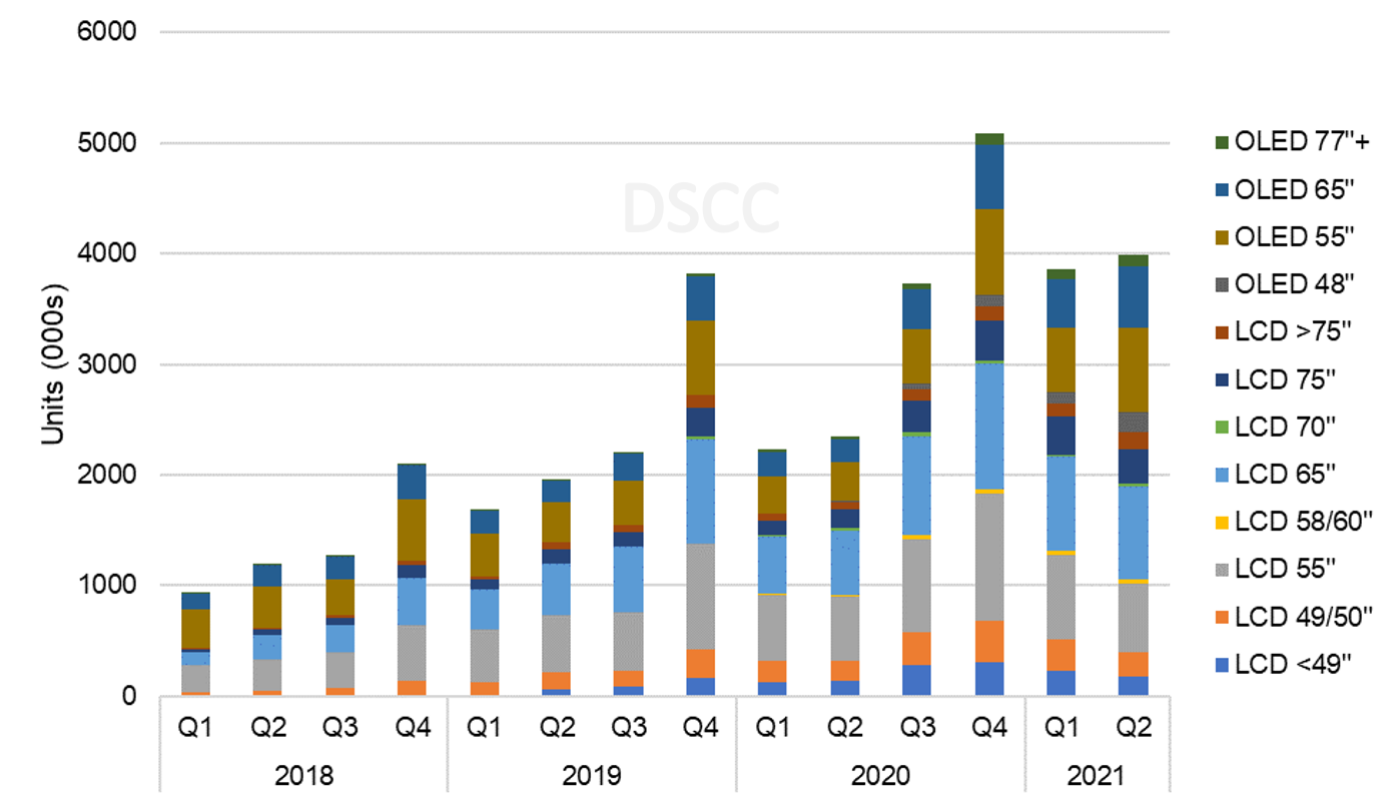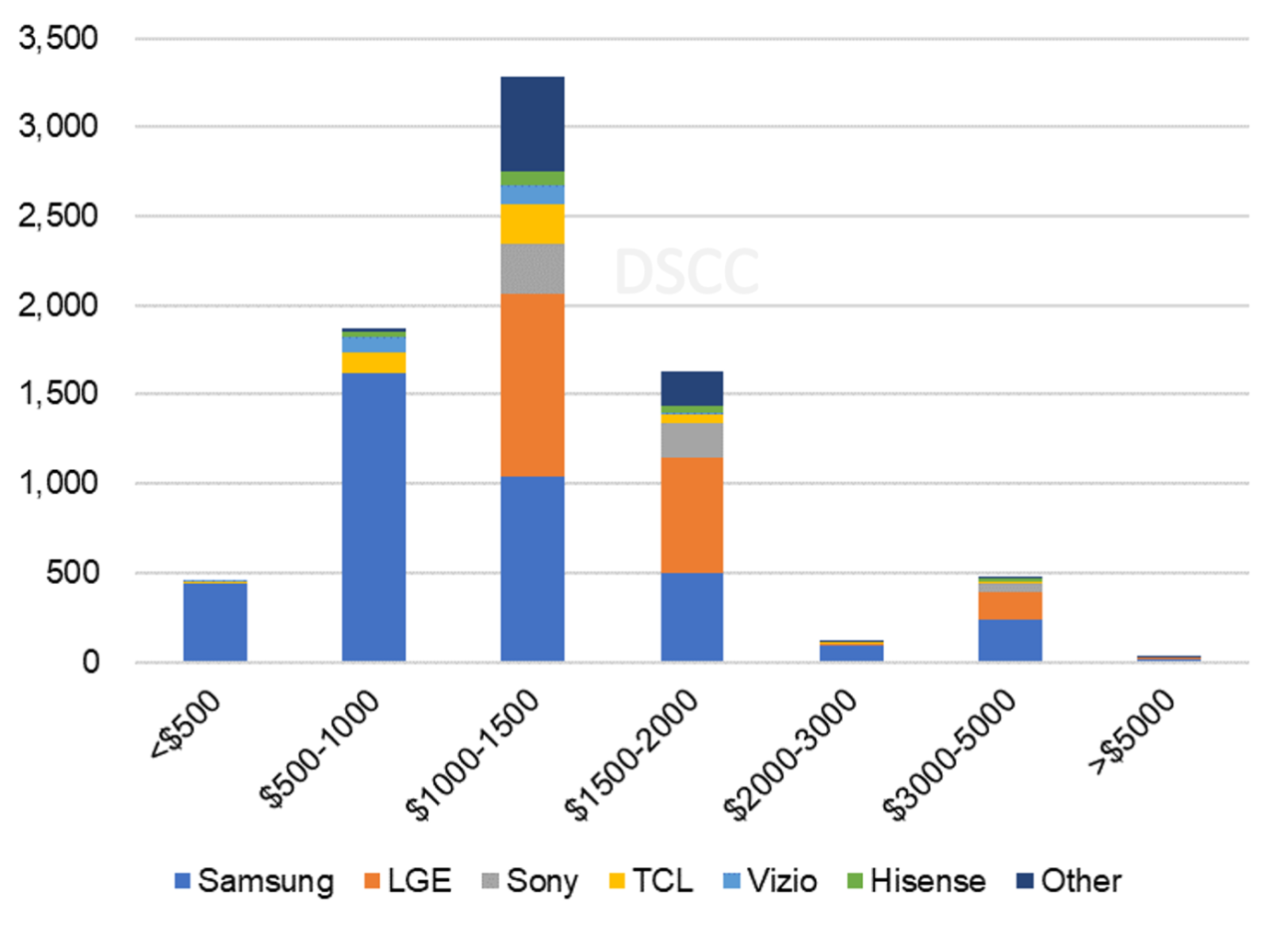国内お問い合わせ窓口
info@displaysupplychain.co.jp
FOR IMMEDIATE RELEASE: 08/19/2021
OLED Share Increased in Booming Advanced TV Market in Q2 2021
Bob O'Brien, Co-Founder, Principal AnalystAnn Arbor, MI USA -
The expanded product range for OLED TV combined with wider availability and increasing LCD TV prices led to a terrific quarter for OLED TV sales, according to the latest update of the DSCC Quarterly Advanced TV Shipment and Forecast Report (一部実データ付きサンプルをお送りします), now available to subscribers. Strong demand for expensive home theater systems from pandemic-constrained consumers led to near triple-digit Y/Y percentage increases in shipments of Advanced TVs, with OLED categories faring even better.
This report covers the worldwide premium TV market, including the most advanced TV technologies: WOLED, QD Display, QDEF, Dual Cell LCD and MiniLED with 4K and 8K resolution. The report looks at current and future TV shipments and revenues by technology, region, brand, resolution and size, and forecasts the growth of all of these technologies. The report includes the shipment result for Q2 2021 and a forecast to 2026. This week we will cover the Q2 2021 results, focusing on the brand competition in the premium segment, and next week we will cover our updated forecast.
We define an “Advanced TV” (capitalized) as any TV with an advanced display technology feature, including all OLED TVs, 8K LCD TVs and all LCD TVs with quantum dot technology. The historical data in the report allows analysis by feature for Advanced LCD TVs, including:
- QDEF TV: TV using a Quantum Dot Enhancement Film; these TVs are sold as “QLED” by Samsung, TCL, and others;
- MiniLED: LCD TVs with a MiniLED backlight, as sold by TCL starting in 2019 and introduced by Samsung, LG, Hisense and others in 2021;
- Dual Cell: LCD TVs employing dual-cell technology, as introduced by Hisense in 2019;
- LCD Others: this category includes LCD TVs with 8K resolution, that do not fall in any other category.
The historical data for OLED TV includes only one product configuration, LGD’s White-OLED (WOLED) technology, but the forecast in the report includes QD Display, which designates QD OLED and successor technologies such as QNED and EL-QLED, as well as Rollable OLED and MicroLED. Our forecast for MicroLED TV is based on product sizes up to 110”, as products in larger sizes such as Samsung’s 146” The Wall, belong in a different category than “TV”.
Advanced TV shipments in Q2 2021 jumped by 70% Y/Y to 4.0M units, as shown in the first chart here. While in 2020 we observed that the smaller screen sizes of Advanced TVs recorded the biggest gains, in the first half of 2021 it was all about the biggest sizes. Advanced LCD TVs of 75” increased 88% Y/Y to 317K, and Advanced LCD TVs larger than 75” increased 121% to 150K, while OLED TVs 77” and larger increased by 308% to 113K, more than the total cumulative volume of this category for all years up to the end of 2019.
While OLED TV share of all Advanced TV had declined during 2018-2020, the additional capacity from LG Display’s Guangzhou fab combined with rising LCD TV panel prices has helped OLED TV regain share in the premium category. OLED TV shipments increased by 169% Y/Y in Q2 2021, while Advanced LCD TV shipments increased by a more modest 36% Y/Y, and OLED TV share increased from 25% in Q2 2020 to 40% in Q2 2021.
Advanced TV Shipments by Size and Display Technology, 2018 to 2021
The report’s pivot tables allow an analysis of brand share by screen size, region, technology, resolution and other variables. In Q2 2021, among all Advanced TV products, Samsung increased unit shipments by 33% Y/Y and maintained its leading position but lost some share with growth slower than the market. LG Electronics increased shipments by 186% with big increases in OLED and some sales of Advanced LCD TVs and LG’s share increased from 15% in Q2 2020 to 25% in Q2 2021. TCL Advanced LCD TV shipments increased by 81% Y/Y but Sony did even better at 173% Y/Y to regain the the #3 position in Advanced TV units with a 9% share.
The report divides worldwide shipments into eight geographic regions. Western Europe and North America have continued to be the largest regions for Advanced TV. These two regions represented a combined 63% of Advanced TV units and 70% of revenue in Q2 2021. Shipments to Western Europe increased 94% Y/Y in Q2 2021 and revenues increased by 108% Y/Y. Shipments to North America increased 86% Y/Y and revenues increased 89% Y/Y as sales of big TVs surged. Shipments and revenues in China increased by 111% and 86% Y/Y, respectively, from Q2 2020, as the third largest region by Advanced TV revenue.
In North America, Samsung enjoys a dominant position on the strength of its large-screen product portfolio but has seen its share erode as competitors in both Advanced LCD and OLED TV grow share. LG increased Advanced TV shipments to North America by 290% Y/Y to increase its unit share to 26%.
In Western Europe, Samsung continued to hold its position as the #1 brand but saw its share erode with increasing competition. Samsung captured 60% share of Advanced TV units in Western Europe in Q2 2021, but that figure was down 11% compared to Q2 2020. Samsung remains ahead of its nearest competitor, but LGE gained at Samsung’s expense with 24% share of units. The Advanced TV market in Western Europe is increasingly becoming a two-horse race as Sony’s share has stagnated and other brands including, Philips and Panasonic, have lost share.
Another interesting cut of the brand data is the battle by screen size. In 55” worldwide unit shipments, Samsung continues to lead but that lead has narrowed. Samsung’s unit share of 55” Advanced TV declined from 50% in Q2 2020 to 36% in Q2 2021, while LG’s share of 55” Advanced TV units increased Y/Y from 20% to 34%. Sony, Panasonic and TCL round out the top five brands for 55” Advanced TV.
In the largest size category of 70”+ Samsung has seen its position erode from a near-monopoly in 2018 to 2019 to mere dominance in 2020-2021 as LGE and Sony sales of 77” OLED and TCL sales of 75” LCD have increased dramatically. In Q2 2021, Samsung still captured 63% unit share of 70”+ Advanced TV shipments, but this figure was down from 77% in Q2 2020. Meanwhile, LG, Sony and TCL gained share.
The last chart here shows one last valuable cut of the data, units by brand by price band. The pivot tables allow for this analysis by any time period, and the chart here shows the market by price band for the first half of 2021. The chart shows that Samsung’s leading position in Advanced TV is mostly a function of its dominance in Advanced TVs under $1000. Samsung’s strategy of pushing its QLED product line toward mainstream price points has allowed it to thrive, but Vizio, TCL and Hisense also appear as competitors at these lower prices. LG’s OLED TVs give it the leading position in the range of $1000-$2000 and a strong position in the market above $3000, and TCL’s MiniLED TVs have given that brand a foothold in the price range of $1000-$2000.
Worldwide Advanced TV Units by Price Band for 1H 2021
DSCC’s Quarterly Advanced TV Shipment and Forecast Report (一部実データ付きサンプルをお送りします) includes technical descriptions of all major advanced TV display technologies, plus quarterly shipment results from Q1 2018 through Q2 2021, sortable by technology, region, brand, resolution and size, and includes pivot tables for analysis of units, revenues, ASPs and other metrics. The report includes DSCC’s quarterly forecast for five years across technology, region, resolution and size. Readers interested in subscribing to the DSCC Advanced TV Shipment Report should contact gerry@displaysupplychain.com.
About Counterpoint
https://www.displaysupplychain.co.jp/about
[一般のお客様:本記事の出典調査レポートのお引き合い]
上記「国内お問い合わせ窓口」にて承ります。会社名・部署名・お名前、および対象レポート名またはブログタイトルをお書き添えの上、メール送信をお願い申し上げます。和文概要資料、商品サンプル、国内販売価格を返信させていただきます。
[報道関係者様:本記事の日本語解説&データ入手のご要望]
上記「国内お問い合わせ窓口」にて承ります。媒体名・お名前・ご要望内容、および必要回答日時をお書き添えの上、メール送信をお願い申し上げます。記者様の締切時刻までに、国内アナリストが最大限・迅速にサポートさせていただきます。

